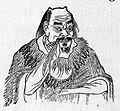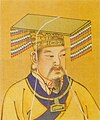Three Sovereigns and Five Emperors
Three Sovereigns and Five Emperors Tam Hoàng Ngũ Đế | |||||||
|---|---|---|---|---|---|---|---|
| Government | Monarchy | ||||||
| Emperor | |||||||
•c. 2852– c. 2738 BC | Fuxi | ||||||
•c. 2737– c. 2638 BC | Shennong | ||||||
•c. 2637– c. 2598 BC | Yellow Emperor | ||||||
•c. 2597– c. 2514 BC | Shaohao | ||||||
•c. 2513– c. 2436 BC | Zhuanxu | ||||||
•c. 2435– c. 2366 BC | Ku | ||||||
•c. 2365– c. 2256 BC | Yao | ||||||
•c. 2355– c. 2206 BC | Shun | ||||||
| |||||||
| Three Sovereigns and Five Emperors | |||||||||||||
|---|---|---|---|---|---|---|---|---|---|---|---|---|---|
| Chinese | Tam Hoàng Ngũ Đế | ||||||||||||
| |||||||||||||
| Part ofa serieson the |
| History of China |
|---|
According toChinese mythologyand traditionalChinese historiography,theThree Sovereigns and Five Emperors(Chinese:Tam Hoàng Ngũ Đế;pinyin:Sān huáng wǔ dì) were a series of sage rulers, and the firstEmperors of China.[1]Today, they are consideredculture heroes,[2]but they were widely worshipped as divine "ancestral spirits" in ancient times. According to received history, the period they existed in preceded theXia dynasty,[3]although they were thought to exist in later periods to an extent[4]in incorporeal forms that aided the Chinese people, especially with the stories ofNüwaexisting as a spirit in theShang dynasty[5]andShennongbeing identified as the godly form ofHou Jiand a founder of theZhou dynasty.[6]
In myth, the Three Sovereigns were demigods who used their abilities to help create mankind and impart to them essential skills and knowledge. The Five Emperors were exemplary sages who possessed great moral character, and were from a golden age when "communications between the human order and the divine were central to all life" and where the sages embodied the divine, or aided humans in communicating divine forces.[7]
In this period theabdication systemwas used beforeQi of Xiaviolently seized power and established a hereditary monarchy.[8]
History[edit]
Taoistmythsand parables involvingshamanisticthemes were likely inspired byTungusicfolklore, as were most ancient stories about the SovereignsFuxi,Nüwa,andShennong.[9]
Variations[edit]

There are six to seven known variations on which people constitute the Three Sovereigns and the Five Emperors, depending on the source.[10]Many of the known sources were written in much later dynasties.
Groupings of the Three Sovereigns consist of some combination of the following:Fuxi,Nüwa,Shennong,Suiren,Zhu Rong,Gonggong,theHeavenly Sovereign,theEarthly Sovereign,theHuman Sovereign(in two varieties), and theYellow Emperor.[1]
Groupings of the Five Emperors consist of some combination of the following: the Yellow Emperor,Zhuanxu,Emperor Ku,Emperor Yao,Emperor Shun,Shaohao,Taihao,and theYan Emperor.
Three Sovereigns[edit]
The Three Sovereigns, sometimes known as the Three August Ones, were said to begod-kingsordemigodswho used their magical powers, divine powers, or being in harmony with theTaoto improve the lives of their people. Because of their lofty virtue, they lived to a great age and ruled over a period of great peace.
The Sovereigns have elements in common withxianfrom theTaoistpantheon, such as theHuman Sovereign's cloud-chariot and their supernatural abilities. Upon his death, the Yellow Emperor was "said to have become" axian.[11]
The Yellow Emperor is supposedly the ancestor of theHuaxiapeople.[12]TheMausoleum of the Yellow Emperorwas established inShaanxito commemorate the ancestry legend.[12]
The Three Sovereigns are ascribed various identities in different historical texts, as shown in the table below:
| According to source | Three Sovereigns |
|---|---|
| Records of the Grand Historian,addition bySima Zhen | Heavenly Sovereign,Earthly Sovereign,Tai Sovereign[10]orFu Xi,Nüwa, Shennong |
| Sovereign series( đế vương thế hệ ) | Fu Xi, Shennong, Yellow Emperor[10] |
| Shiben | Fu Xi, Shennong, Yellow Emperor[10] |
| Baihu Tongyi( Bạch Hổ thông nghĩa ) | (1st variation) Fu Xi, Shennong,Zhu Rong[10] (2nd variation) Fu Xi, Shennong, Suiren[10] |
| Fengsu Tongyi | Fu Xi, Nüwa, Shennong[10] |
| Yiwen Leiju | Heavenly Sovereign,Earthly Sovereign;Human Sovereign[10] |
| Tong gian Waiji( thông giam ngoại kỷ ) | Fu Xi, Shennong, Gonggong |
| Chunqiu yundou shu( xuân thu vận đấu xu ) Chunqiu yuanming bao( xuân thu nguyên mệnh bao ) |
Fu Xi, Nüwa, Shennong |
| Shangshu dazhuan( thượng thư đại truyền ) | Fu Xi, Shennong, Suiren |
| Diwang shiji( đế vương thế kỷ ) | Fu Xi, Shennong, Yellow Emperor |
Five Emperors[edit]
The Five Emperors were traditionally thought to have invented "fire, writing and irrigation".[13]Like the Three Sovereigns, they are ascribed different identities depending on historical source, as shown in the table below:
| According to source | Five Emperors |
|---|---|
| Records of the Grand Historian | Yellow Emperor, Zhuanxu, Ku, Yao, Shun[10] |
| Sovereign Series( đế vương thế kỷ ) | Shaohao, Zhuanxu, Ku, Yao, Shun[10] |
| I Ching | Taihao ( quá hạo ), Yan Emperor, Yellow Emperor, Yao, Shun[10] |
| Comments of a Recluse,Qianfulun ( tiềm phu luận ) | Taihao, Yan, Yellow Emperor, Shaohao, Zhuanxu[14][better source needed] |
| Zizhi tong gian waiji,( Tư Trị Thông Giám ngoại kỷ ) | Yellow Emperor, Shaohao, Zhuanxu, Ku, Yao[14] |
Five Emperors family tree[edit]
| (1)Yellow Emperor[15] | |||||||||||||||||||||||||||||||||||||||||||||||||
| (2)Shaohao | Changyi | ||||||||||||||||||||||||||||||||||||||||||||||||
| Jiaoji | (3)Zhuanxu | ||||||||||||||||||||||||||||||||||||||||||||||||
| (4)Ku | Qiongchan | Sb. | |||||||||||||||||||||||||||||||||||||||||||||||
| (5)Zhi | (6)Yao | Houji | Jingkang kính khang | Sb. | |||||||||||||||||||||||||||||||||||||||||||||
| Danzhu | Juwang | Sb. | |||||||||||||||||||||||||||||||||||||||||||||||
| {{{ la danh [Luoming]}}} | |||||||||||||||||||||||||||||||||||||||||||||||||
| Qiaoniu kiều ngưu | Gun | ||||||||||||||||||||||||||||||||||||||||||||||||
| Gusou | (8)Yu | ||||||||||||||||||||||||||||||||||||||||||||||||
| Ehuang | (7)Shun | Nuying | |||||||||||||||||||||||||||||||||||||||||||||||
| Shangjun | |||||||||||||||||||||||||||||||||||||||||||||||||
Creation myth[edit]
There is the legend of the Four Clans ( bốn thị ) who took part in creating the world,Youchao-shi ( có sào thị ),Suiren-shi ( toại người ),Fu Xi-shi ( Phục Hy thị ), andShennong-shi ( Thần Nông thị ).[16]
Legacy[edit]
These Sovereigns and Emperors are said to have helped introduce the use of fire, taught people how to build houses, and invented farming. The Yellow Emperor's wife is credited with the invention ofsilk culture.The discovery ofmedicineand invention of thecalendarandChinese scriptare also credited to the kings. After their era,Yu the Greatfounded theXia dynasty,traditionally considered the first dynasty inChinese historiography.[3]
Gallery[edit]
-
Shennong tasting herbs to discover their qualities
-
Historian's depiction of the Yellow Emperor
-
Another depiction of the Yellow Emperor
References[edit]
- ^ab"Tam Hoàng Ngũ Đế – quốc học võng"[Three Sovereigns and Five Emperors – Chinese Studies Network] (in Chinese (China)). 2012-08-16.Retrieved2023-09-18.
- ^Hucker, Charles (1995).China's Imperial Past: An Introduction to Chinese History and Culture.Stanford University Press. p. 22.ISBN978-0-8047-2353-4.
- ^abMorton, W. Scott; Lewis, Charlton M. (2005).China: its history and culture(4th ed.). New York: McGraw-Hill. p. 14.ISBN978-0-07-141279-7.
- ^Scarpari, Maurizio (2006).Ancient China: Chinese Civilization from the Origins to the Tang Dynasty.Translated by Milan, A.B.A. New York: Barnes & Noble. p. 28.ISBN978-0-7607-8379-5.
- ^Ni, Xueting C. (2023).Chinese Myths: From Cosmology and Folklore to Gods and Immortals.London: Amber Books. pp. 76–77.ISBN978-1-83886-263-3.
- ^Asim, Ina (2007)."Keynotes 2".University of Oregon.Retrieved2023-07-18.
- ^Willard Gurdon Oxtoby, ed. (2002).World Religions: Eastern Traditions(2nd ed.). Don Mills, ON: Oxford University Press. pp. 324, 326.ISBN0-19-541521-3.OCLC46661540.
- ^Feng, Shi (2009)"A Study of the Pottery Inscription 'Wen Yi văn ấp '".Chinese Archaeology,Vol. 9 (Issue 1), pp. 170-177.full text
- ^Palmer, Martin(1999).The Elements of Taoism.United States: Barnes & Noble. p. 15.ISBN0-7607-1078-3.
- ^abcdefghijkLưu vĩ /. (2002) Chinese civilization in a new light. Commercial press publishing. ISBN 962-07-5314-3, p. 142.
- ^"Huangdi".Encyclopedia Britannica.Retrieved2023-05-22.
- ^abWang, Hengwei (2006) [2005].Trung Quốc lịch sử giảng đường[Chinese history lecture hall] (in Chinese). Zhonghua shuju. p. 13.ISBN962-8885-24-3.
- ^Clayre, Alasdair(1985).The Heart of the Dragon(First American ed.). Boston: Houghton Mifflin. p. 37.ISBN978-0-395-35336-3.
- ^ab"CHINAKNOWLEDGE",Chinese History - The Three Augusts and Five Emperors Tam Hoàng Ngũ Đế
- ^Records of the Grand Historian
- ^Wang 2006,pp. 4–7.
Further reading[edit]
- "Ssŭma Ch'ien'sHistorical Records,Introductory Chapter ".Journal of the Royal Asiatic Society.26(2). Translated by Allen, Herbert J.: 269–295 1894.doi:10.1017/S0035869X00143916.
- "The Annals of the Bamboo Books: The reigns of Huang-te, Che, Chuen-heuh and Hëen-Yuen; The reigns of Yaou and Shun".The Chinese Classics, volume 3, part 1.Translated byLegge, James.1865. pp. 108–116.





